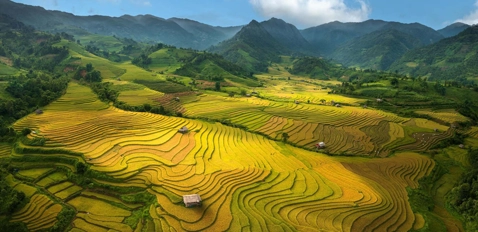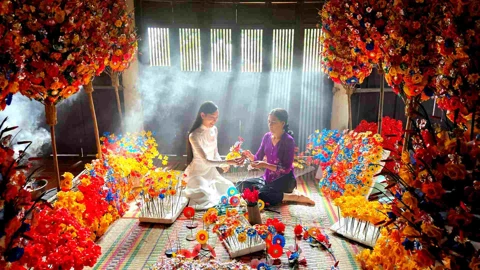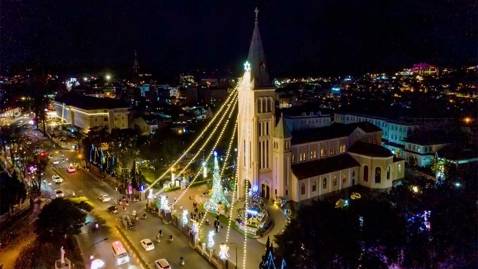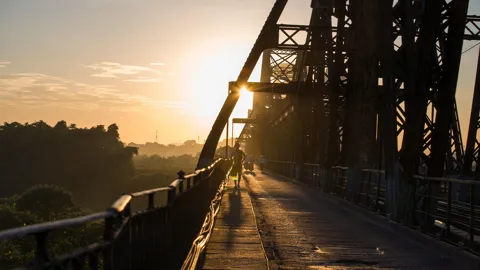Hanoi or Ho Chi Minh City: Which City To Choose To Discover Vietnam?
Vietnam’s two largest cities—Hanoi or Ho Chi Minh City—present distinct portraits of the country. One pulses with centuries of imperial culture, while the other soars with modern ambition. If you're planning your first visit, choosing between Hanoi or Ho Chi Minh City can define your experience. Let’s explore twelve key comparisons to help you decide where to begin discovering Vietnam.
General Atmosphere
Hanoi exudes old-world charm wrapped in the energy of daily life. It captivates with its peaceful atmosphere, enchanting Hoan Kiem Lake, centuries-old temples, and Old Quarter with its narrow streets lined with old-fashioned shops. Here, the pace is slow, the morning silence is punctuated by the song of street vendors, and traditions still hold sway.
In contrast, Ho Chi Minh City—often casually called Saigon—pulses with dynamic energy. It embodies youth, speed, and renewal. Its futuristic skyscrapers, trendy late-night cafes, and modern neighborhoods reflect the country's economic momentum. The sense here is of a nation racing forward.
So if you want to start with slower-paced charm, choose Hanoi. If you want a more modern and faster outlook, visit Ho Chi Minh City instead.
History And Heritage
Hanoi is the cultural heart of Vietnam. Its history stretches back over a thousand years as Vietnam's capital under various dynasties. The Old Quarter still retains narrow alleys and traditional tube houses, and sites like the Imperial Citadel, Temple of Literature, and venerable pagodas bear testament to a rich past.
Meanwhile, Ho Chi Minh City reflects colonial and wartime history—French architecture like Notre-Dame Cathedral and the Central Post Office coexist with sites from modern history like the War Remnants Museum and Cu Chi Tunnels. It’s a city whose identity is profoundly shaped by more recent decades: that of French colonization, and both Indochina Wars.
Art Of Living
Hanoi’s art of living lies in its simplicity and ritual. Morning tai chi at Hoan Kiem Lake, sipping strong drip coffee from plastic stools, chatting over bún chả in sidewalk eateries, and making social connections in small ways define daily life.
Ho Chi Minh City’s art of living is more cosmopolitan and influenced more the West. People are fashion-forward, tech-savvy, and global-minded. Street food vendors serve up pho or bánh mì beside sleek co‑working spaces and evening live music. It's a city in constant flux, attracting enterprising minds.
Cuisine And Gastronomy
Hanoian cuisine is influenced heavily by Chinese cuisine, plus it's also a reflection of the people. Therefore, it's refined, light, and balanced, with moderate use of sugar and chili peppers, allowing aromatic herbs to shine and dazzle any eaters. Notable dishes include the light and delicate Pho, or the precise and fragrant Bun Thang.
In contrast, southern cuisine is more explosive in flavors, and often more generous in quantity. Diverse immigrant communities influence global fusion too, such as the famous Hu tieu, a blend of Chinese and Khmer cuisine.
Architecture
Hanoi’s architecture blends imperial temples, colonial French buildings, Art Deco villas, Soviet-era blocks, and small tube houses. The historic center remains on a human scale, making it pleasant to explore on foot. You can wander around Ba Dinh, Hoan Kiem, and West Lake to see centuries of evolution in just a few kilometers.
In Ho Chi Minh City, urban planning is booming, with a skyline dominated by skyscrapers such as the Bitexco Financial Tower and Landmark 81. Neighborhoods like District 1 combine art galleries, cocktail bars, and air-conditioned shopping malls.
The contrast is stark, evoking different eras: Hanoi is layered history; Ho Chi Minh City is modern ambition.
Activities And Discoveries
In Hanoi
- Strolling around Hoan Kiem Lake offers a peaceful break in the heart of Hanoi, between peaceful nature, scenes of local life and the timeless charm of Vietnamese legends.
- Exploring the Old Quarter means diving into the authentic soul of Hanoi, between lively alleys, colonial houses and small traditional shops with timeless charm.
- Visiting the Ho Chi Minh Mausoleum allows you to delve into the history of Vietnam by paying homage to the “Father of the Nation” in a solemn place, imbued with respect and contemplation.
- Attending a water puppet show is like diving into the soul of ancient Vietnam, between traditional music and folk stories brought to life on the waves.
- Enjoying egg coffee in Vietnam means savoring a unique blend of sweetness, warmth, and tradition in a cozy and authentic atmosphere.
- Hanoi Street Food: A festival of authentic flavors where every corner becomes an invitation to taste local specialties like steaming pho, savory bun cha, or crispy spring rolls.
In Ho Chi Minh City
- Discovering Ben Thanh Market is like diving into the heart of Saigon's commercial soul, between colorful stalls, the scent of spices, and vibrant local crafts.
- Visiting the Cu Chi Tunnels allows you to delve into the heart of the history of the Vietnam War through an impressive underground network, dug by Vietcong fighters.
- Strolling along Nguyen Hue Pedestrian Street is like immersing yourself in the vibrant heart of Ho Chi Minh City, between illuminated fountains, modern buildings and lively scenes of life.
- Drinking a cocktail on a rooftop means savoring the moment from above, facing the illuminated city, between a light breeze and a breathtaking panoramic view.
- Exploring Chinatown (Cholon) means immersing yourself in a vibrant neighborhood of a thousand colors, blending Chinese temples, lively markets, traditional medicine shops and a unique atmosphere of ancient Asia.
- Street Food in Ho Chi Minh: A whirlwind of flavors on every street corner, from steaming soups to grilled skewers and crispy pancakes, in a lively and authentic atmosphere.
Weather And Climate
Hanoi has four seasons: chilly winters (Dec–Feb), wet springs (Mar–May), hot summers (Jun–Aug), and pleasant autumns (Sep–Nov). If you're traveling in spring or autumn, it’s comfortable; winter may require warm layers, as temperature usually dips down below 15°C (59°F), while summer requires constant hydration, as temperatures can reach around 40°C (104°F).
Ho Chi Minh City is tropical and has only two seasons: wet (May–Nov) and dry (Dec–Apr), with consistently warm temperatures of 25–35 °C (77–95 °F). The humidity is relatively high year-round (around 78%), which can cause some discomfort.
Accessibility And Transportation
Both cities has quite good international airports. Hanoi’s Noi Bai Airport and Ho Chi Minh City’s Tan Son Nhat Airport connects widely in Asia and domestically. They are also important transmissions center to many other tourist attractions in their respective regions. But the similarities stop there.
Since around Hanoi is many mountainous regions, travelling to other tourist hotspots in the North is harder and much more tiring. In contrast, you can easily reach famous destinations in the South in less time thanks to the absence to terrain differences.
Within Hanoi, public buses, cyclos, taxis, ride-share motorbikes and sky rail are methods you can use to get around the city. The dense urban areas means it's also much more friendlier for those who want to travel on foot. Meanwhile, Ho Chi Minh City doesn't have cyclos or sky rail, but can be proud with the first underground metro. The streets are also much wider, favoring motor vehicles over walking.
Cost Of Living
As major urban centers, both cities have comparable living costs—but nuance matters.
Hanoi offers lower prices for lodging, food, and drinks in local neighborhoods. Tourist areas can be pricier.
Ho Chi Minh City is slightly more expensive—rent and rooftop bar cocktails dominate—but still affordable by Western standards. While choosing Hanoi or Ho Chi Minh City, consider travel style: Hanoi is more budget-friendly; HCMC may invite more indulgence.
Nightlife
Nightlife differs dramatically between Hanoi or Ho Chi Minh City.
In Hanoi, evening energy is quite subdued: beer on sidewalks, concerts, traditional shows, night walks around the lake, and relaxed lounges define the night.
Ho Chi Minh City pulses after dark—with night markets, live music bars, DJ club scenes, and rooftop venues. Districts like District 2, 4, 7, and especially District 1 host tons of nightlife variety. If you want to have a wild night, Ho Chi Minh City is clearly the winner.
Shopping
Shopping in Vietnam is more than just a tourist activity: it's a true sensory journey, between vibrant colors, spicy aromas, and artisanal know-how. But both cities offer vastly different experiences.
In Hanoi, shopping still focuses heavily on small craft shops, local boutiques and markets, which retain a popular and authentic atmosphere. At Dong Xuan Market, one of the oldest in the capital, you can wander through a joyful chaos where fabrics, medicinal herbs, bamboo souvenirs, and everyday items mingle. A good chunk of the goods are traditional Vietnamese crafts and fashion: Van Phuc silk, Bat Trang ceramics, embroidered conical hats, Ao dai, fine lacquerware, Dong Ho prints, etc.. Prices are often a little lower, especially for handcrafted or local products. Bargaining is part of the game, especially in markets or small shops.
On the other end of the spectrum, Ho Chi Minh City is home to the country's largest shopping malls: Saigon Centre, Takashimaya, AEON Mall, Landmark 81... The markets here are also often larger, more organized, more commercially oriented, and more cosmopolitan, offering a more eclectic range of souvenirs, including Mekong Delta crafts, Khmer- and Chinese-inspired objects, and contemporary creations. Fashion is more influenced by Western and Korean trends. Young local designers are launching trendy ready-to-wear brands. Urban shoppers will definitely prefer Ho Chi Minh City for its avant-garde side. Prices are higher in tourist areas, but you can find good deals in wholesale markets (especially in Cholon) or during sales in shopping malls.
All in all, choosing between shopping in Hanoi and Ho Chi Minh City means choosing between two worlds: the authenticity, tradition, and artisanal poetry of the capital, or the dynamism, trendiness, and internationalism of the center of the southern regions.
Security
In terms of safety, both Hanoi and Ho Chi Minh City offer a relatively safe environment for travelers. Violent crime is rare, and serious crimes against tourists are exceptional. Both cities benefit from a discreet but effective police presence, especially in tourist areas.
That said, some differences can be noted:
- In Hanoi, safety in historic areas like the Old Quarter is generally good, especially at night. The streets are well lit and the atmosphere is relatively calm. Risks are limited to minor scams or pickpockets in crowded or dark areas.
- In Ho Chi Minh City, the busier pace of the city can lead to more minor incidents, particularly snatch and grab theft in certain areas such as District 1. It is advisable to avoid displaying phones or jewelry in the street and to use secure shoulder bags.
In both cases, by adopting a few basic precautions – not walking alone at night in deserted streets, not leaving your belongings unattended, and using reliable taxis or apps (Grab) – you can travel worry-free. Trust your intuition—both Hanoi and Ho Chi Minh City are safe, but urban caution is still needed.
Excursions Around Hanoi And Ho Chi Minh City: What Can You Discover?
When traveling to Vietnam, it would be a shame to limit yourself to the big cities. Around Hanoi and Ho Chi Minh City, there are numerous excursions, allowing you to immerse yourself in nature, culture, and the daily lives of the Vietnamese. But the landscapes, activities, and atmosphere vary greatly depending on the region. Here's a detailed list to help you make the right choice for your needs.
Hanoi
Craft villages – half day
Just a few kilometers from Hanoi, traditional villages like Bat Trang (ceramics), Van Phuc (silk) or Quang Phu Cau (incense) allow you to discover ancestral skills that are still alive.
Ninh Binh – 1 to 2 days
Nicknamed "Halong Bay on land," Ninh Binh offers spectacular landscapes of rice paddies surrounded by karst peaks, which can be explored by boat, bicycle, or on foot. The Hoa Lu temples, Bich Dong Pagoda, and Trang An are locations that you shouldn't missed.
Halong Bay – 2 to 3 days
An already famous location, with its thousands of unique-shaped islands, rising from the emerald waters. It can be explored on a traditional junk with an overnight stay, or on a more modern cruise.
Mai Chau and Pu Luong – 2 to 4 days
For an immersion in the lives of the White Thai ethnic group, head to Mai Chau and the Pu Luong Nature Reserve. Hiking, overnight stays with locals, and the serenity of the rice terraces are on the agenda.
Sapa – 3 to 5 days
Accessible by train or overnight bus, Sapa is perched in the mountains near the Chinese border. Here, you'll discover magnificent landscapes and the cultures of the Hmong, Dao, and Tay peoples. It's the ideal destination for trekking enthusiasts.
Ho Chi Minh City
Cu Chi – half day to full day
Less than a two-hour drive away, the Cu Chi Tunnels provide insight into Vietnamese resistance during the war. An impressive site worth visiting for those interested in contemporary history.
Can Gio – 1 day
This biosphere reserve is located in the mangroves south of the city and is considered a haven of biodiversity. Monkeys, crocodiles, and birds can be seen here in a protected environment.
Vung Tau – 1 to 2 days
Fancy a trip to the sea? Vung Tau Beach is a favorite weekend getaway for Saigon residents. Accessible by speedboat or bus, it offers a breath of fresh sea air and some delicious seafood.
Mekong Delta – 1 to 3 days
A two-hour drive from the city, the Mekong Delta reveals a fascinating aquatic world: floating markets, tropical orchards, canals lined with coconut trees, houses on stilts... Here you can experience with all your senses, from seeing the beautiful scenery, smelling and tasting local fruits, listening to Đờn ca tài tử, the locals' folk music, and touching and feeling with local crafts.
Da Lat or Phu Quoc Island – 2 to 4 days
With a short domestic flight, it is possible to reach the romantic city of Da Lat in the Central Highlands. Nicknamed the "City of Flowers" or the "Little Paris" of Vietnam, is a must-see destination, full of charm and freshness, with offers of breathtaking landscapes, historical monuments, and incredible natural sites. Alternatively, you can go to Phu Quoc, a true gem in the Gulf of Thailand, renowned for its idyllic beaches, lush nature, and crystal-clear waters, perfect for a seaside extension.
Our Commitment To Responsible Tourism In Both Cities
At Vietnam Original Travel, we firmly believe that traveling is more than just sightseeing. It's about understanding, respecting, and immersing yourself in the soul of a place. In both Hanoi and Ho Chi Minh City, our commitment to responsible tourism translates into concrete actions that enhance heritage, protect the environment, and support local communities.
In Hanoi, a city with ancient charm and a rich cultural heritage, we favor authentic experiences: guided walking tours in the old quarter, traditional craft workshops, meetings with locals passionate about their city. Our tours encourage gentle discovery, off the beaten track and respecting sacred and historical places.
In Ho Chi Minh City, a bustling metropolis undergoing rapid change, we promote sustainable initiatives such as eco-friendly accommodations, local restaurants that showcase local produce, and cycling tours through the city's historic districts and the Mekong Delta. We work with partners who share our values and are committed to reducing their environmental footprint.
Our vision of travel is based on a balance: offering unforgettable experiences to visitors while contributing positively to local life. Whether you choose Hanoi or Ho Chi Minh City, you will be accompanied with kindness and responsibility, for a more united, more humane, and more sustainable Vietnam.
Hanoi Or Ho Chi Minh City
Choosing between Hanoi or Ho Chi Minh City is a bit like choosing between heritage and ambition, tradition and trend. Hanoi is introspective, calm, and steeped in history; its charm lies in everyday rituals and hidden corners. Ho Chi Minh City is outward-looking, aspirational, and dynamic. It races forward in skyscrapers, nightlife, and culinary boldness.
But why choose? The richest experiences come from visiting both. Starting in Hanoi and ending in HCMC (or vice versa) lets you experience Vietnam’s north-south spectrum: different climates, cuisines, histories—and a deeply layered understanding of the nation. At heart, these two cities complement each other, like the yin and yang of an eternally fascinating Vietnam.
Send us your comments about : Hanoi or Ho Chi Minh City: Which City To Choose To Discover Vietnam?
Required fields *
You might also be interested
Travel ideas
Need some inspiration? Discover some of the best tours in Vietnam, which are highly appreciated by our clients. An excellent starting point to help you choose the right trip to Vietnam, Laos, Cambodia, Burma or Thailand, whether you are traveling alone, as a couple, as a family or with friends.
And because this trip is yours, feel free to customize it as you wish!
Vietnam Cambodia Itinerary 14 Days
Hanoi – Hoa Binh – Mai Chau – Ninh Binh – Halong bay – Hue - Danang – Hoian – Saigon – Ben Tre - Can Tho – Saigon - Siem Reap Angkor - Tonlé Sap - Siem Reap – Ta Prohm - Departure
Vietnam 14 Day Itinerary
Vietnam 14-day itinerary covers the country’s top highlights and quintessential experiences for an unforgettable journey.
Honeymoon Tour Pakcages In Vietnam 12 Days
Saigon Arrival - City Tour – Mekong Delta – Danang – Hoian - by flight - Da Nang – Hanoi - by flight – Halong - overnight on junk – Departure
Authentic Hoang Su Phi Trekking Tours
Hoang Su Phi trekking tours take you to stunning terraces, meet few tourists, connect with locals and enjoy authentic culture.
Best Nha Trang Beach Tour 4 Days
Saigon/Hanoi – Nha Trang relaxation – Saigon/Hanoi – Departure
Mekong Delta Bike Tour Itinerary 7 Days
Cycle through the Mekong Delta in 7 days, discovering floating markets, orchards, craft villages, and tranquil green islands.
Are you interested in this tour?





































Comment